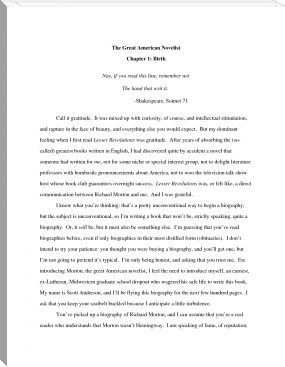The Ocean and Its Wonders by R. M. Ballantyne (free novel reading sites .TXT) 📖

- Author: R. M. Ballantyne
Book online «The Ocean and Its Wonders by R. M. Ballantyne (free novel reading sites .TXT) 📖». Author R. M. Ballantyne
Again, in March, he says, “Last night the ice closed, shutting up our lane; but its opposite sides continued for several hours to move vast each other, rubbing off all projections, crushing and forcing out of the water masses four feet thick. Although one hundred and twenty yards distant, this pressure shook the ship and cracked the intervening ice.”
Soon after that, a heavy gale burst upon them from the south-east, encircling them with snow-drift so dense that they could neither hear nor see what was going on twenty yards off. At night the ship became suddenly detached from her wintry bed, and heeled over to the storm, inducing them to believe that the whole pack had been broken in, and was pressing against them. This was not the case. A large mass of ice had protected them; but at a distance of about fifty yards, ice of four and a half feet thick had been crushed to atoms. Soon after, the protecting mass yielded, and the Fox received a nip which lifted her stern about a foot, while occasional groaning from her sturdy little hull replied to the wild surgings of the ice without.
But all this was as nothing compared with the scene of desperate turmoil and confusion which took place when the ice finally broke up, and a gale raised a fearful swell; so that the Fox found herself surrounded by huge masses, which tossed and ground against each other furiously, and any two of which pieces could have crushed in her sides as if she had been made of walnut shell. Gradually the pack opened out, and the vessel, by aid of wind and steam, was mercifully delivered from her dangerous position.
Before passing from the subject of risk to navigators to the consideration of other forms and aspects of polar ice, let us take a glance at an effectual case of nipping. There have been many partial and severe nips, the descriptions of which are all more or less graphic; but few ships have come so suddenly to the end of their career as did the Breadalbane, a small vessel that was used as a transport ship to the expedition in search of Sir John Franklin in 1852. One who was on board when it occurred thus describes it:—
Sunday, August 21st.—About ten minutes past four, the ice passing the ship awoke me, and the door of my cabin, from the pressure, opened. I hurriedly put on my clothes, and on getting on deck found some hands on the ice endeavouring to save the boats; but the latter were instantly crushed to pieces. They little thought, when using their efforts to save the boats, that the ship was in so perilous a situation.
I went forward to hail the Phoenix (another ship that was fortunately near) for men to save the boats; and whilst doing so, the ropes by which we were secured parted, and a heavy nip took us, making every timber creak, and the ship tremble all over. I looked in the main hold, and saw the beams giving way. I hailed those on the ice, and told them of our critical situation, they not for one moment suspecting it. I then rushed to my cabin, hauled out my portmanteau on deck, and roared like a bull to those in their beds to jump out and save their lives. The startling effect on them might be more easily imagined than described. On reaching the deck, those on the ice called out to me to jump over the side, that the ship was going over. I left my portmanteau, and jumped over the side on the loose ice, and with difficulty, and with the assistance of those on the ice, succeeded in getting on the unbroken part, with the loss of the slippers I had on when quitting the vessel, with wet feet, etcetera. The cold was little thought of at the exciting moment—life, not property, being the object to be saved.
“After being on the ice about five minutes, the timbers, etcetera, in the ship cracking up as matches would in the hand, it eased for a short time; and I, with some others, returned to the ship, with the view of saving some of our effects.
“Captain Inglefield now came running towards the ship, and ordered me to see if the ice was through it. On looking down into the hold, I saw all the beams, etcetera, falling about in a manner that would have been certain death to me had I ventured down there. But there was no occasion for that (I mean to ascertain the fact of the ice being through), it being too evident that the ship could not last many minutes. I then sounded the well, and found five feet in the hold; and, whilst in the act of sounding, a heavier nip than before pressed out the starboard bow, and the ice was forced right into the forecastle. Every one then abandoned the ship, with what few clothes they saved—some with only what they had on. The ship now began to sink fast, and from the time her bowsprit touched the ice until her mast-heads were out of sight, did not occupy above one minute and a half!
“It was a very sad and unceremonious way of being turned out of our ship. From the time the first nip took her, until her disappearance, did not occupy more than fifteen minutes.”
Such is the account of the fate of the Breadalbane. While we read it, we cannot help feeling that many arctic ships must have perished in a similar manner. It is wonderful, nevertheless, how many of those that dare the dangers of the ice survive the conflict. Undoubtedly this is owing, to a large extent, to the fact that ships’ bottoms are rounded; so that when a severe nip takes place, there is a tendency in the ice to slip under their rounded bottoms, and squeeze the vessels up out of the water. Were it not for this, few ships that have gone to those seas would ever have returned.
A catastrophe such as that which befell the Breadalbane shows the immense power of field-ice. Hundreds of somewhat similar incidents might be cited to illustrate this power; but we content ourselves with the selection of one instance, which exhibits it in a remarkable manner, and at the same time shows the way in which heavy vessels are sometimes forced out of the water.
In the year 1836, Captain Back commanded the Terror, which was sent out to make geographical discoveries in the polar regions, and spent the winter of that year in the ice. Few ships have undergone severer tests than did the Terror on that voyage. The severest treatment she experienced was in the spring, when the disruption of the winter ice began to take place. The evening of the 7th of March was specially fraught with danger. We quote the gallant commander’s graphic account:—
“Ominous rushing sounds were heard far off to the north-east and north-west. These gradually drew nearer as the flood made its way, either under the compact bodies that withstood the shock, or along the cracks and openings—gaining in these latter a furious velocity, to which everything seemed to yield.
“It happened that there were several of these around the ship; and when they opened on us like so many conduits pouring their contents to a common centre, the concussion was absolutely appalling, rending the lining and bulkheads in every part, loosening some shores and stanchions, so that the slightest effort would have thrown them down, and compressing others with such force as to make the turpentine ooze out of their extremities. One fir plank, placed horizontally between the beams and the shores actually glittered with globules. At the same time the pressure was going on from the larboard side, where the three heaviest parts of the ruin of the floe remained, cracked here and there, but yet adhering in firm and solid bodies. These, of course, were irresistible; and after much groaning, splitting, and cracking, accompanied by sounds like the explosion of cannon, the ship rose fore and aft, and heeled over about ten degrees to starboard.”
Again, on the 11th, Back says: “At this time she showed symptoms of suffering in the hull, which was evidently undergoing a severe ordeal. Inexplicable noises, in which the sharp sounds of splitting and the harsher ones of grinding were most distinct, came in quick succession, and then again stopped suddenly, leaving all so still that not even a breath was heard.
“In an instant the ship was felt to rise under our feet, and the roaring and rushing commenced with a deafening din alongside, abeam and astern, at one and the same instant. Alongside, the grinding masses held the ship tight as in a vice; while the overwhelming pressure of the entire body, advancing from the west, so wedged the stern and starboard quarter, that the greatest apprehensions were entertained for the stern-post and framework abaft.
“Some idea of the power exerted on this occasion may be gathered from this:— At the moment which I am now describing, the fore-part of the ship was literally buried as high as the flukes of the anchors in a dock of perpendicular walls of ice; so that, in that part, she might well have been thought immovable. Still, such was the force applied to her abaft, that after much cracking and perceptible yielding of the beams, which seemed to curve upwards, she actually rose by sheer pressure above the dock forward; and then, with sudden jerks, did the same abaft. During these convulsions, many of the carpenters and others stationed below were violently thrown down on the deck, as people are in an earthquake. It was a moment of intense suspense.
“On the 16th, another rush drove irresistibly on the larboard quarter and stern, and forcing the ship ahead, raised her on the ice. A chaotic ruin followed... The ship was careened fully four streaks, and sprang a leak as before. Scarcely were ten minutes left us for the expression of our astonishment that anything of human build could outlive such assaults, when another equally violent rush succeeded; and in its way toward the starboard quarter threw up a rolling wave thirty feet high, crowned by a blue square mass of many tons, resembling the entire side of a house, which, after hanging for some time in doubtful poise on the ridge, at length fell with a crash into the hollow, in which, as in a cavern, the after-part of the ship seemed embedded. It was, indeed, an awful crisis, rendered more frightful from the mistiness of the night and dimness of the moon.
“The poor ship cracked and trembled violently, and no one could say that the next minute would not be her last—and, indeed, his own too, for with her our means of safety would probably perish.”
It is unnecessary to give additional instances of this kind, in order to show the terrible power of field-ice. Indeed, it requires little in the way of illumination to prove that masses of solid matter, many thousands of tons in weight, can, when in motion, utterly destroy the most powerful engines of human construction.
We shall now turn our attention to another, and a very prominent form, in which arctic ice presents itself—namely, that of icebergs.
There are not only ice-fields, ice-floes, etcetera, in the polar seas, but there are ice-mountains, or bergs.
It was long a matter of uncertainty as to where and how
 Have you ever thought about what fiction is? Probably, such a question may seem surprising: and so everything is clear. Every person throughout his life has to repeatedly create the works he needs for specific purposes - statements, autobiographies, dictations - using not gypsum or clay, not musical notes, not paints, but just a word. At the same time, almost every person will be very surprised if he is told that he thereby created a work of fiction, which is very different from visual art, music and sculpture making. However, everyone understands that a student's essay or dictation is fundamentally different from novels, short stories, news that are created by professional writers. In the works of professionals there is the most important difference - excogitation. But, oddly enough, in a school literature course, you don’t realize the full power of fiction. So using our website in your free time discover fiction for yourself.
Have you ever thought about what fiction is? Probably, such a question may seem surprising: and so everything is clear. Every person throughout his life has to repeatedly create the works he needs for specific purposes - statements, autobiographies, dictations - using not gypsum or clay, not musical notes, not paints, but just a word. At the same time, almost every person will be very surprised if he is told that he thereby created a work of fiction, which is very different from visual art, music and sculpture making. However, everyone understands that a student's essay or dictation is fundamentally different from novels, short stories, news that are created by professional writers. In the works of professionals there is the most important difference - excogitation. But, oddly enough, in a school literature course, you don’t realize the full power of fiction. So using our website in your free time discover fiction for yourself. 




Comments (0)